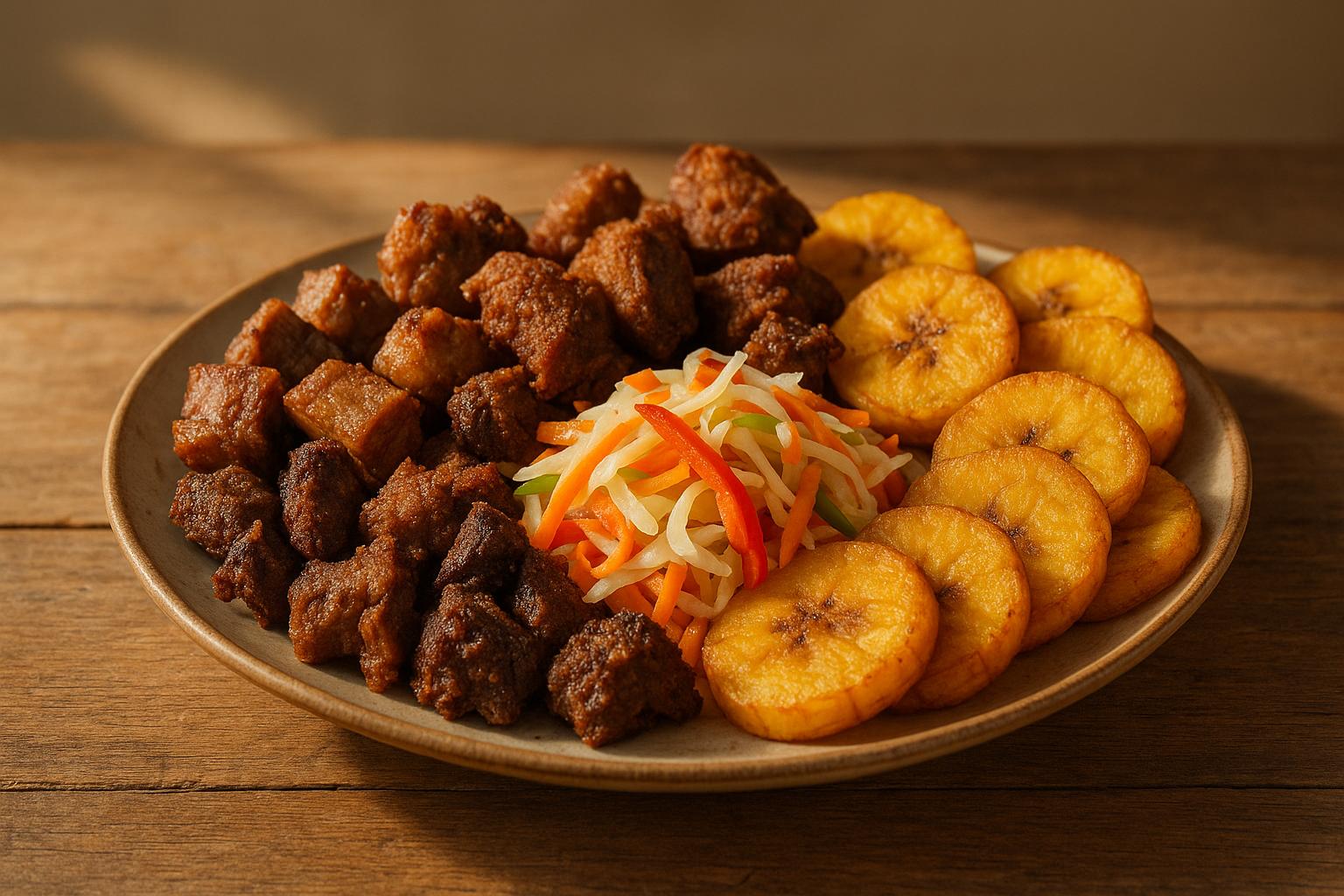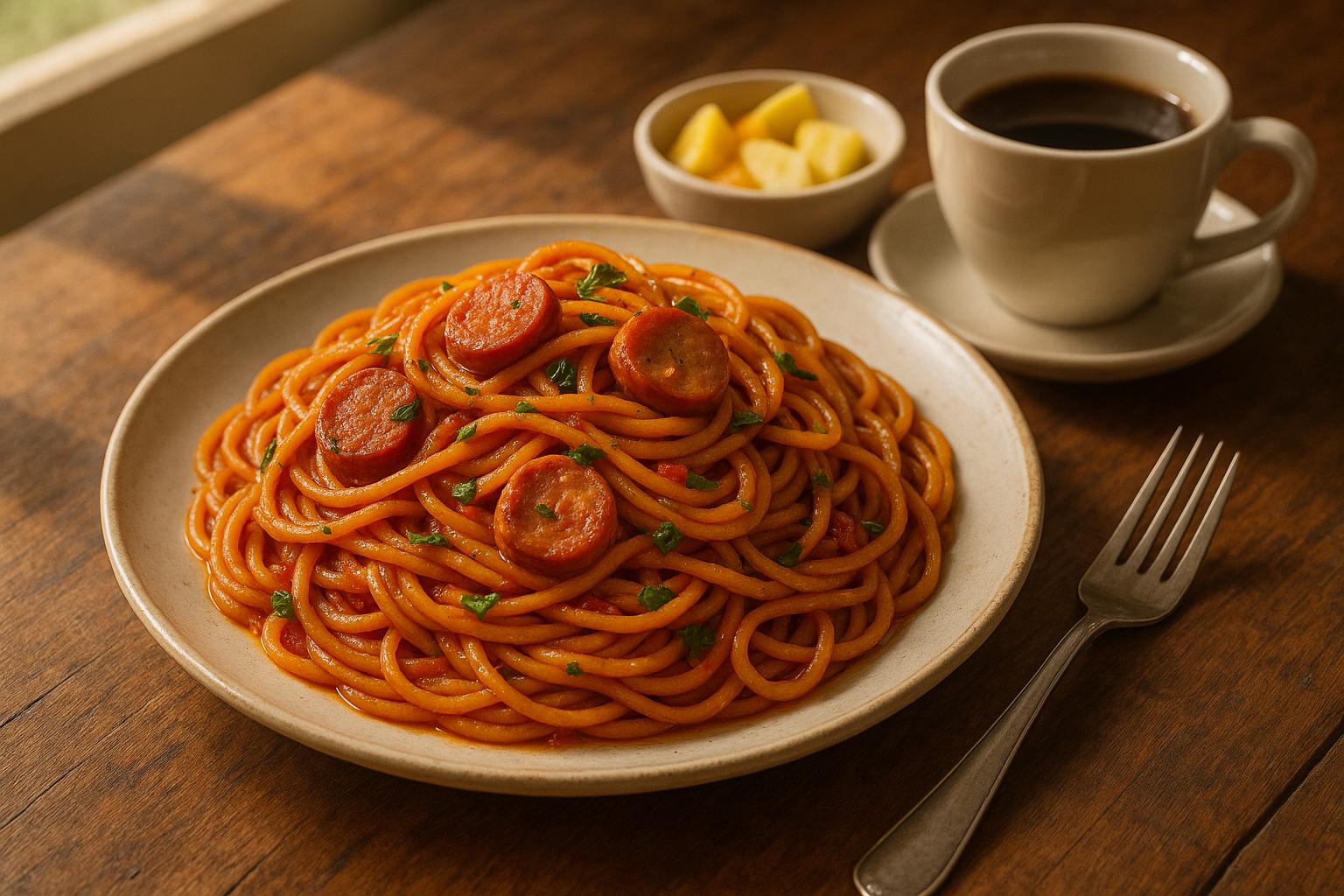Lambi Creole, also known as conch stew, is a flavorful Haitian dish featuring tender conch meat cooked in a spicy, aromatic sauce. Here's a quick guide to making it:
-
Key Steps:
- Clean and Tenderize: Remove conch from its shell, clean thoroughly, and tenderize by pounding.
- Marinate: Use lime juice, Haitian epis (green seasoning), garlic, parsley, thyme, and citrus for bold flavors.
- Cook Slowly: Simmer in a rich base of onions, bell peppers, tomatoes, and stock for 1.5–2 hours.
-
Ingredients:
Conch meat, lime, sour orange, garlic, onions, peppers, tomatoes, Haitian epis, parsley, thyme, Scotch bonnet, and stock. - Substitutes: If conch is unavailable, shrimp, scallops, calamari, or crab meat are good alternatives.
- Serving Suggestions: Pair with white rice, fried plantains, or Haitian Black Rice.
This dish highlights Haitian cuisine's bold flavors and historical roots. Follow the detailed steps for a delicious meal that’s rich in taste and history.
Sourcing and Preparing Conch (Lambi)
Where to Buy Conch in the US
Finding high-quality conch in the U.S. often means heading to specialty seafood markets that cater to Caribbean communities. In areas with a strong Haitian, Jamaican, or Bahamian presence, Caribbean grocery stores frequently stock frozen conch meat, perfect for making Lambi Creole. Coastal cities like Miami, New York, and Boston are also good hunting grounds, where high-end seafood counters may carry it. If you're not near these areas, online seafood retailers and local fish markets are worth checking out. Some Asian seafood markets might stock conch as well, though it could be labeled differently. Always call ahead to confirm availability before making the trip. Once you have your conch, the next step is cleaning and tenderizing it for the best flavor and texture.
How to Clean and Tenderize Conch
If you’ve got a whole conch, the first task is removing it from its shell. This can be done with a hammer and chisel, or you can ask your fishmonger to handle it for you.
Once the conch is out of the shell, peel off the tough outer skin to expose the pale meat underneath. Trim away any dark or slimy areas, including the stomach sac and visible organs. Afterward, rinse the meat thoroughly under cold water. Since conch tends to be naturally chewy, tenderizing it is a must. Use a mallet or the back of a heavy knife to pound the meat until it’s about ¼ inch thick, breaking down the muscle fibers. After tenderizing, cut the conch into bite-sized pieces, roughly 1–2 inches.
For an extra step in flavor and tenderness, rinse the pieces in fresh lime or sour orange juice. This citrus bath not only enhances the taste but also softens the meat further. Let the conch sit in the citrus juice for 15–20 minutes before moving on to your recipe. Once prepared, your conch is ready for the next stage: cooking with aromatics.
Substitute Ingredients
If conch is hard to find, there are several seafood options that can work as substitutes. Shrimp is an excellent alternative, as it absorbs citrus flavors beautifully. When using shrimp, consider adding extra lime juice or even a whole orange to your marinade to intensify the flavor.
Scallops are another great option, offering a sweet, delicate taste and a tender texture when cooked properly. Large sea scallops can be cut into chunks, much like conch, and they hold up well during longer cooking times without becoming tough.
Here’s a quick guide to possible substitutes:
| Substitute | Flavor Profile | Texture | Preparation Tips |
|---|---|---|---|
| Shrimp | Mild, sweet | Tender | Use large shrimp; add extra citrus for flavor |
| Scallops | Sweet, delicate | Buttery and tender | Cut into chunks; avoid overcooking |
| Calamari | Mild, slightly briny | Tender or chewy | Tenderize thoroughly; cook quickly or very slowly |
| Crab Meat | Sweet and rich | Flaky and tender | Use lump crab; add at the end of cooking |
Crab meat is another option, offering a sweetness similar to conch, though its flaky texture is quite different. For a more adventurous choice, lionfish also pairs well with the flavor profile of Lambi Creole.
While these substitutes can deliver delicious results, the buttery texture and sweet, crab-like flavor of well-prepared conch remain unmatched. If you can get your hands on fresh conch, it’s absolutely worth the effort.
Ingredients and Tools You'll Need
Key Ingredients for Lambi Creole
To make a proper Lambi Creole, you'll need specific ingredients that bring out its authentic flavors. Here's what to gather:
The Star Ingredient:
- 2 lbs fresh or frozen conch meat: Make sure it's cleaned and tenderized for the best results.
Aromatics and Base:
- 1 large yellow onion, diced
- 1 large bell pepper (red or green), chopped
- 3-4 shallots, minced
- 4 cloves garlic, minced
- 2 scallions, chopped (separate the white and green parts)
- 1 large leek: Can be used as a substitute if scallions aren't available.
Flavor Builders:
- 3 tbsp Haitian epis: This is a green seasoning blend that’s a must for authentic flavor.
- 2 tbsp tomato paste
- 2 large tomatoes, diced
- 1 Scotch bonnet or habanero pepper, minced (remove the seeds if you prefer less heat)
- Juice of 2 limes
- 1 sour orange: If unavailable, use extra lime juice as a substitute.
Herbs and Spices:
- 2 tbsp fresh parsley, chopped
- 1 tbsp fresh thyme leaves
- 1 tsp ground black pepper
- 1 tsp salt (adjust to taste)
- 2 bay leaves
- ½ tsp ground clove
- 1 tsp paprika
Liquid and Fat:
- 2 cups seafood or chicken stock
- 3 tbsp vegetable or olive oil
- 1 tbsp butter (optional, for added richness)
If substitutions are needed, refer to the guidelines mentioned earlier.
Kitchen Tools You'll Need
Having the right tools is just as important as the ingredients. Here’s what you’ll need to prepare Lambi Creole:
Essential Cookware:
A heavy-bottomed Dutch oven or a large saucepan (at least 4-quart capacity) is ideal. The thick base helps prevent burning during the slow cooking process required to tenderize the conch. If you're pressed for time, a pressure cooker or Instant Pot can reduce the cooking time from 2 hours to about 45 minutes.
Prep Tools:
A sturdy cutting board and a sharp chef's knife are must-haves for chopping all the ingredients. To tenderize the conch meat, use a meat mallet or the back of a heavy knife - this step is key to achieving the perfect texture.
Measuring and Mixing:
Accurate spice ratios are crucial, so keep standard measuring cups and spoons on hand. A wooden spoon is excellent for stirring, as it won’t scratch your cookware and handles thick mixtures effectively. If needed, use a fine-mesh strainer to remove any grit from the conch or strain your stock.
Additional Tools:
A citrus juicer will save you time when extracting lime and sour orange juice. Tongs are helpful for flipping the conch during browning. If you're working with whole conch, a hammer and chisel will be necessary to remove the shell - but most U.S. markets offer pre-shucked conch, making this step unnecessary.
Step-by-Step Instructions
Cleaning and Marinating the Conch
Start by rinsing the conch under cold water to wash away any grit. Then, rub the juice of one lime over the conch to help neutralize any odors and begin the tenderizing process.
Using a mallet, pound each piece of conch until it's evenly tender. After that, cut the conch into uniform 1-inch pieces to ensure even cooking.
Now, it's time to prepare the marinade. In a large bowl, mix together minced garlic, Haitian epis, fresh thyme, chopped parsley, salt, black pepper, and minced shallots. Add the juice from the remaining lime along with sour orange juice. The citrus not only enhances the flavor but also helps tenderize the meat.
Pour this seasoning mix over the conch pieces, tossing them until they're fully coated. Cover the bowl with plastic wrap and refrigerate. While a quick 30-minute marinade will add some flavor, letting it rest overnight will allow the spices to deeply infuse the conch, delivering bold and rich flavors when cooked.
Once the marination is complete, you're ready to move on to building the aromatic base.
Cooking Aromatics and Simmering the Dish
Begin by creating a flavorful vegetable base. Heat vegetable oil in a Dutch oven over medium heat. Add the diced onions and sauté for about 3 to 4 minutes until they turn translucent.
Next, toss in the chopped bell pepper and the white parts of the scallions. Stir occasionally and cook for another 2 to 3 minutes, letting the vegetables soften slightly while maintaining some texture. Push the vegetables to the side, add tomato paste to the pot, and cook it for about a minute to enhance its flavor.
Mix the tomato paste into the vegetables, then add diced tomatoes and bay leaves. Let the mixture cook for about 5 minutes, allowing the tomatoes to break down into a chunky sauce.
Take the marinated conch out of the refrigerator and add it to the pot, including all the marinade liquid - this liquid is packed with concentrated flavor, so don’t toss it out! Turn the heat to medium-high and cook the conch for 5 to 7 minutes, stirring frequently.
Pour in seafood stock and bring the mixture to a boil. Once it starts boiling, lower the heat to a gentle simmer, cover the pot, and let it cook for 1.5 to 2 hours. Stir every 30 minutes to prevent sticking and ensure even cooking. This slow simmering process is key to breaking down the conch's tough fibers. If you're using a pressure cooker, you can cut the cooking time to about 45 minutes under high pressure.
Final Adjustments and Serving
Check the conch by piercing it with a fork - it should be tender and easy to cut. If it's still tough, let it cook for another 15 to 20 minutes and test again.
Taste the sauce and adjust the salt if needed. For a touch of heat, stir in a small amount of minced Scotch bonnet pepper. Discard the bay leaves and finish the dish by stirring in a small knob of butter for a silky richness. Sprinkle the green parts of the scallions over the dish, allowing them to wilt slightly from the residual heat. The sauce should be thick enough to coat the conch pieces without drying out.
Serve the dish hot, paired with white rice or fried plantains. Alternatively, some people love to enjoy it with bread to soak up every last bit of the flavorful sauce. Fun fact: this dish often tastes even better the next day as the flavors continue to develop, making it an excellent choice for meal prep or hosting guests.
sbb-itb-80c33ff
Tips for Best Results and Serving
Why Slow Cooking Matters
After carefully cleaning and marinating, these final steps are key to making your Lambi Creole tender and packed with flavor. The trick? Patience. Conch meat has tough fibers that need time to break down. If you rush it, you’ll end up with meat that’s chewy and rubbery - not exactly ideal.
Simmer the conch over medium-low heat for 1.5–2 hours. If you're in a hurry, a pressure cooker can cut this time down to about 90 minutes. This slow cooking process allows the collagen in the meat to break down, resulting in tender, flavorful bites.
One important tip: skip the vinegar at the start. While lime or sour orange juice works great for marinating, vinegar can prematurely "cook" the conch, making it tough. Once you start cooking, keep the heat steady at medium-low. A gentle simmer prevents the meat from tightening up and turning rubbery. With these techniques, you’ll have the perfect base to adjust flavors to your liking.
Recipe Variations
Lambi Creole is incredibly versatile, allowing you to tweak it to suit your taste and dietary preferences. The level of heat, for example, is entirely up to you.
"Haitian lambi is typically spicy, thanks to Scotch bonnet or hot peppers in the seasoning. The heat level can vary depending on who's cooking, but the spice is part of what makes it so flavorful."
– Savory Thoughts [1]
For a milder version, use half a Scotch bonnet or swap it out for a milder pepper. Watching your sodium intake? Skip the bouillon cubes and lean on fresh herbs like parsley, cilantro, and thyme for flavor. Once you've fine-tuned the spices, you’ll have a dish that’s uniquely yours.
Pair it with some classic sides to complete the meal.
What to Serve with Lambi Creole
Lambi Creole pairs beautifully with traditional Haitian sides that enhance its bold flavors. Popular options include Haitian Black Rice, fried plantains (Bannann Peze), yellow yams, Mayi Moulen (cornmeal), or May Moulin Ak Zepina (cornmeal with spinach). Haitian white rice or red beans and rice are also excellent choices [1].
For drinks, Haitian Kremas - a creamy rum punch made with evaporated milk, sweetened condensed milk, cream of coconut, and warming spices like cinnamon and nutmeg - is a perfect match [17, 19, 20]. If you prefer nonalcoholic options, try Haitian Pineapple Nog, a blend of pineapple, coconut milk, and nutmeg, or Akasan, a refreshing corn flour shake [19, 20].
Savory Thoughts - Amazingly Delicious Haitian Lambi - Conch Stew

Conclusion
By following this step-by-step guide, you're well on your way to mastering the art of preparing Lambi Creole. This dish is your ticket to bringing the bold, rich flavors of Haitian cuisine straight into your kitchen. The secret? It’s all in the preparation - cleaning and tenderizing the conch thoroughly, giving it plenty of time to marinate, and embracing the slow cooking process. Patience pays off, as simmering slowly transforms the conch into tender, flavorful bites that are worth every minute.
Whether you stick to the traditional spicy kick of Scotch bonnet peppers or opt for a milder version, the essential steps remain the same. The result is always a dish that proudly showcases the heart of Haitian cooking.
But Lambi Creole isn't just about the food - it’s a celebration of Haitian heritage. Pair it with staples like Haitian black rice, fried plantains, or cornmeal, and you’ve got a meal that reflects centuries of culinary tradition and culture.
Hungry for more Haitian recipes and insights? Head over to the "Read About Haitian Cuisine, Traditions, and Dishes" section on HaitianFoods.org. There, you’ll find guides for making dishes like Haitian Chicken Stew, Bouillon with Crab, and Pwason Nan Sos. You can also explore articles on Haitian culinary traditions, from the enduring use of clay pots to the Taino influence on smoking techniques.
Every recipe you try brings you closer to experiencing the soul of Haitian culture. Dive deeper into this vibrant cuisine and uncover more recipes and stories at HaitianFoods.org.
FAQs
How can I make sure the conch is tender when preparing Lambi Creole?
To prepare tender conch meat for Lambi Creole, start by gently pounding it with a meat mallet or rolling pin. This helps break down the tough fibers. Another option is soaking the conch in water mixed with a splash of vinegar for about an hour, which can further soften it. Alternatively, you can boil the conch in salted water for roughly an hour before cooking. These techniques will give your dish the ideal texture.
Can I use a pressure cooker to prepare Lambi Creole, and how will it change the cooking time?
Using a pressure cooker to prepare Lambi Creole is a fantastic way to cut down on cooking time. Traditionally, tenderizing conch can take 1.5 to 2 hours of simmering, but with a pressure cooker, you can achieve the same tenderness in just 20-25 minutes at high pressure.
This approach not only saves time but also helps lock in flavor and ensures the conch turns out perfectly tender. Just make sure to thoroughly clean and season the conch beforehand for the best taste.
What are the best sides to pair with Lambi Creole for a true Haitian dining experience?
For a true taste of Haiti, pair Lambi Creole with classic sides like rice and beans (Diri ak Pwa), fried plantains (Bannann Peze), and pikliz, a fiery pickled vegetable relish. These accompaniments not only highlight the savory richness of the conch but also infuse your meal with the vibrant essence of Haitian culinary traditions.
To round it all out, consider serving a refreshing drink such as freshly squeezed limeade or passion fruit juice. These traditional additions bring harmony to the meal, turning it into a flavorful tribute to Haitian cuisine.


